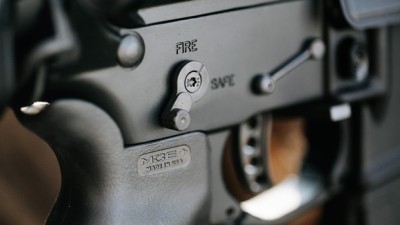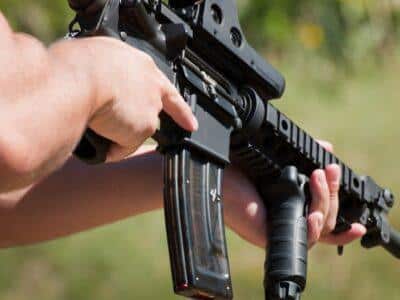5 Modifications To Make Your AR-15 Obscenely Reliable
In a recent article, The Big Problem With Semi-Automatic Rifles For Survival, I discussed several reasons why such weapons would prove inadequate for survival-type situations. And although I still maintain many of these opinions, I also enjoy viewing the issue from other perspectives (because, honestly, that’s what makes these conversations darn interesting.)
With that said, I decided to talk about the strengths of the AR-15, and to even address a very strong pointthat had been made in the comments section: while I might not necessarily see semi-autos as an optimal weapon for my particular tastes, this doesn’t necessarily negate the fact that they would still offer massively superior attributes in comparison to, say, a bolt gun in various instances, such as:
- For those who have had extensive training and even combat experience with semi-auto rifles, it would make far more sense to stick with the weapon you know best.
- For someone who wisely believes different weapons are required for different tactical needs. If military unit will carry more than one type of firearm into a combat zone, then so, too should a civilian. If you’re in the process of bugging out with a group, then having a semi-auto or two would provide a massive advantage … because a lever gun just doesn’t get the rounds down-range in near the volume that an AR with a 30-round mag actually can. Let’s just say, we’d be morons for leaving them at home. Fire superiority is a very, very advantageous thing, indeed.
The AR-15 is THE American battle rifle for a reason, and when comparing its pros and cons to other semi-autos, it really does hold its own with ease. Between its inherent ergonomic advantages, its weight — at least, if we’re talking about gas (non-piston) systems — and its excellently designed iron sights, the AR design just gets the job done — much the way it has for decades in the hands of those in the US Armed Forces and domestic law enforcement.
But while I have found the modern production AR to reliably outperform a stamped-receiver AK-47on the reliability factor — believe it or not — I can’t say that I’d turn my nose up at an opportunity to further cement the longevity and trustworthiness of my AR. So, here are five aftermarket modifications that can turn this workhorse into an armored workhorse with an attitude.
1. Cold Hammer Forged Barrel
Quite frankly, if there were one particular part of the AR that I’d consider THE MOST important, then I’d have to say that it would have to be the barrel. However, not to get too far ahead of ourselves, there’s a difference between what’s considered “accuracy” for a precision bench shooter, and what’s considered accurate enough for general combat applications.
Personally, if I can reliably nail any part of a pie plate at 300 yards with my AR’s irons, then I’d call that a win. But that’s not the only aspect of the barrel that needs our attention. Some have found sub-MOA accuracy variations in groupings from 6,000 rounds to experiencing major accuracy problems after 25,000 rounds after being fired through a chrome-lined barrel.
While I might say that these figures are still rather staggering (and much of them remain hearsay), there’s still a possible problem in considering a survival possibility: How many rounds will you HAVE to fire before having the luxury of replacing the barrel or the rifle itself? Quite personally, I’m not in favor of entrusting such a thing to luck.
This is why I’d simply suggest getting a higher-quality cold hammer forged barrel from a reputable company, such as Daniel Defense or BCM. These barrels are known for being extremely durable, and due to their manufacturing process, they will also have the lowest possible potential for factory defects.
2. Nickel Boron Bolt Carrier Group

There are quite a few AR-15 authorities that aren’t convinced in the usefulness of the nickel boron bolt carrier group; however, again, I’d have to say that this depends upon the application at hand.
For instance, one of the reasons why I’d want to build up my AR’s reliability/durability capacities to cover my hind parts during a possible bugout scenario is because, well, that’s the nature of a bugout scenario. It’s going to be unpredictable. So if I can remove as many weapon-malfunction variables as possible, then I will.
I believe that a nickel boron bolt carrier group is a great way to do just that. To validate my findings, I recently discovered this comprehensive review from The Truth About Guns to be quite helpful, discussing the ease of cleaning one of the rifle’s most important (and often the dirtiest) parts of the weapon’s functioning internals:
“All it took was 30 seconds of rubbing the bolt with a cloth towel and it immediately returned to its original mirror finish. The only place where I had to scrub a bit to remove the carbon was the rear of the bolt, but even that took considerably less time and effort than with a traditional phosphate bolt carrier.”
I’ve heard no shortage of positive praises of the nickel boron bolt carriers, especially from Spikes Tactical; however, don’t be surprised to drop $204 on this purchase alone.
3. Protective Coating
This is, perhaps, one of the most obvious ways to protect the longevity of your AR-15, especially if you’re stuck in an environment that will put your baby through constant moisture and friction hardships. Giving your AR a sturdy application of Duracoat or Cerakote will offer two advantages to your rifle system:
- First, you’ll be able to better shelter your AR from the corrosion-causing elements, and give it just another barrier of protection.
- Second, (provided you’ve selected a color scheme that makes sense) the coating can provide an additional camouflage factor, which can give you just one more tactical advantage.
Of course, especially with aftermarket AR mods, such things will cost a pretty penny. If you do DIY, then you won’t have to pay upwards of $200-$300 to have someone else do it — but do be careful, because this is one job that’s very easy to botch.
4. Upgrade Your Magazines
This aftermarket mod actually has little to do with the rifle itself, but apparently, expert testing has put this issue in the forefront when it comes to AR reliability problems: magazines. According to David Crane of Defensive Review, he believes that this is actually in the top two reasons in why our taxpayer-funded AR rifles fail in combat:
“If we remove magazines from the equation as an extremely problematic item, the remaining parts critical for inspection and routine replacement are the extractor and spring. From my experience they are the biggest culprits in M4/M4A1 malfunctions, aside from bad magazines.”
The good part is that this is actually somewhat of an easy fix, especially on an individual civilian level. If anything, the key here is to avoid purchasing questionable magazines and stick with the ones that have a strong reputation for a low failure/malfunction rate.
In this case, the Magpul PMAG always seems to take its place somewhere on or around the top of the “favorites list” when it comes to high-performing magazines. Magpul has always been an impressive company in my opinion, and it was largely their stellar magazines that had originally won the company its earliest clout in the tactical gear industry.
5.Replace Springs and Bring Along Extras
But let’s not forget what David Crane had mentioned in the last pointer above.
 Not only were magazines a massive culprit of AR issues: many of such failures and malfunctions were largely a result of problems with the rifle’s springs. And for good reason, especially since it’s the weapon’s springs which provide the controlled opposing reaction to the energy delivered by the gas. The most critical wear and tear will occur here, because the extractor and buffer springs take the hardest operational abuses — and their failure effectively transforms the rifle into a less efficient bolt-gun. However, here’s what Crane’s assessment said in particular,
Not only were magazines a massive culprit of AR issues: many of such failures and malfunctions were largely a result of problems with the rifle’s springs. And for good reason, especially since it’s the weapon’s springs which provide the controlled opposing reaction to the energy delivered by the gas. The most critical wear and tear will occur here, because the extractor and buffer springs take the hardest operational abuses — and their failure effectively transforms the rifle into a less efficient bolt-gun. However, here’s what Crane’s assessment said in particular,
“I routinely went well over 2,500 rounds with only a few drops of oil and a bore snake run through the barrel every morning. I was convinced there and then that fouling was not nearly the issue it was purported to be, and that the real issue was weak springs and a buffer that was too light.”
Now, I will say that it might not be a smart call to simply replace your springs with heavier ones … and then leave it sitting in the safe until doomsday.
If you’re going to change out the springs, then it’s important that you need to make sure that they aren’t, either too heavy, or still too light for the AR’s gas system to function properly. While there arestandard specifications which can give a general idea on how to mod your rifle’s springs, you should still make sure to get in the necessary range time to assess if the new springs are working properly.
Your Build. Your Testing. Your Conclusions
Ultimately, that’s what it comes down to: no matter how you modify your AR, you need to make sure that you give her the necessary range time in order to know what works — and more importantly — what doesn’t.
And whether or not the mods that I’ve suggested will work for your particular rifle or not, the main takeaway is that you should implement changes that make for a better, more durable, more reliable and more accurate rifle. Because these are extremely fine-tuned weapons, and AR-15s will perform differently to others just like them. Hence, the critical need for you to get out there and test your own mods.
However, the more range time you get, the better you know your rifle. The better you know your rifle, the more you know what it needs and how to keep it working for you — and not failing when you need her most.
Tags:
"Destroying the New World Order"
THANK YOU FOR SUPPORTING THE SITE!
Latest Activity
- Top News
- ·
- Everything
Mossad: we create a pretend world, we are a global production company... the world is our stage
The Alvin II Encounter: Was There A Living Dinosaur Involved?
All In The Family | Mike Meets Archie For The First Time | The Norman Lear Effect
entitlement
Death Threats for Assisting ICE?
'They’re Waiting for Us to Die': Area 51 Veterans Plead for Trump’s Help | Elizabeth Vargas Reports
© 2025 Created by truth.
Powered by
![]()
